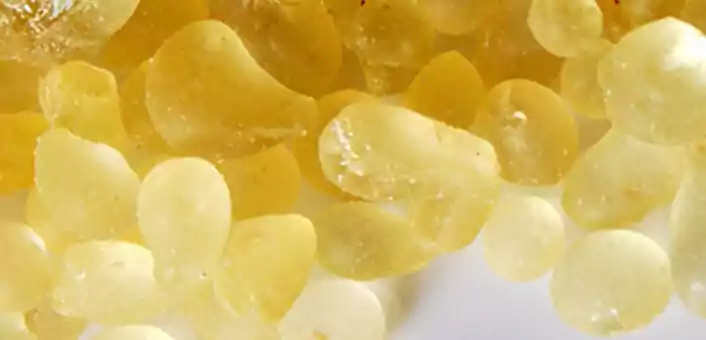PCOS test is based on the Rotterdam criteria for diagnosing PCOS.

Acid Reflux
Mastic gum is a resin secreted by the tree Pistacia lentiscus that grows mainly on the Greek island of Chios. This tree is also known as Chios mastic. The resin of this tree has been used by the people of the Mediterranean and North African region for centuries to treat ailments of the stomach and mouth, fungal infections, respiratory problems, and even bad breath. Mastic gum is now being considered by researchers for its ability to treat gastritis, stomach ulcers, acid reflux, and inflammatory bowel disease.
In a double-blind controlled clinical trial of mastic gum in patients with duodenal ulcer, researchers found that it had an ulcer-healing effect and was well tolerated without any side effects.
In a study involving 148 patients with functional dyspepsia, researchers from the Chios Island found that mastic gum significantly improved symptoms. Another study found that it influenced the growth of Helicobacter pylori which has been implicated as the root cause of acid reflux. Overgrowth of H. pylori causes inefficient indigestion. This, in turn, may give rise to a variety of chronic health conditions, including GERD (Gastroesophageal reflux disease). H. pylori infection can also cause stomach ulcers.
In a study performed at the dental school of the Cukurova University, Turkey, researchers observed that mastic gum had significant antibacterial activity against Streptococcus mutans – the primary oral pathogen that causes dental caries. They saw a strong relationship between bad oral health and a variety of health conditions, including endocarditis and cardiovascular diseases. They also claim that periodontitis is linked to premature birth and low birth weight.
A review published in Antimicrobial Agents and Chemotherapy concluded that the conventional therapy for treating H. pylori infections, which included a combination of an antibiotic and a proton pump inhibitor, resulted in the emergence of antibiotic-resistant strains of bacteria mainly due to poor patient compliance (when patients fail to complete the antibiotic course) and other reasons. The researchers studied the activity of mastic gum (without the sticky polymer) in lab experiments involving individual H. pylori strains as well in mice. They found that its long-term use can reduce the load of H. pylori from the gut. Thus, they concluded that the intake of mastic gum was a safe and viable alternative therapy for treating H. pylori infections.
Another study, which has assessed the liver-protective effects of mastic gum showed that it was able to significantly decrease total serum cholesterol, SGOT, and SGPT levels.
Mastic gum inhibits the inflammatory activities of the immune system that can cause stomach ulcers in response to an H. pylori infection by inhibiting an enzyme called protein kinase C (PKC). This enzyme activates cells to produce oxidizing compounds that cause oxidative damage to cells (and eventually, an inflammatory response). This damage leads to an ulcer.
It also affects the function of activated macrophages (cells of the immune system that release biologically active substances to trigger a local immune response) by inhibiting the production of pro-inflammatory substances. This activity can reduce symptoms of many autoimmune diseases in which inflammation is the basic cause of discomfort.
More than 70 different bioactive compounds have been isolated from mastic gum. The compounds that possess the strongest antimicrobial activity appear to be a combination of verbenone, linalool, and α-terpineol. These compounds work synergistically to kill a variety of bacteria.
It is either available as raw resin pieces removed from the mastic tree or as a powdered extract usually packaged in capsules.
Studies that concluded the anti-ulcer activity of mastic gum used a dosage of 1 g per day. This dosage of mastic gum can be administered as two doses of 500 mg or four doses of 250 mg per day. For maintaining gastrointestinal health, two doses of 250 mg per day appear to be sufficient.
The fact that mastic gum has been used by locals of the Mediterranean region since thousands of years attests to its safety. However, since it is a plant product, some people may be allergic to one or more of its constituents. In case you experience allergic symptoms (rash, reddening of skin, or difficulty in breathing), you should discontinue and consult your doctor immediately.
There have been no studies regarding the effects of mastic gum intake during pregnancy and breastfeeding. It is always safe to consult your doctor before taking it.
Biochemical analyses of mastic gum reveal what our ancestors knew thousands of years ago – that it is a veritable treasure-trove of highly active and potent bioactive compounds capable of exhibiting a wide range of beneficial effects on our health.
It can cure an H. pylori infection and subsequently GERD and stomach ulcers. It also has positive effects on the liver, a major organ controlling digestion and detoxification processes of the body. It can also be taken as a supplement because it is active, safe, and efficient.
https://www.ncbi.nlm.nih.gov/pubmed/6395994?dopt=Abstract
https://www.sciencedirect.com/science/article/pii/S0378874109007284
https://www.sciencedirect.com/science/article/pii/S0944711309002396
https://www.sciencedirect.com/science/article/pii/S0003996905002669
https://aac.asm.org/content/51/2/551.full#sec-18
https://www.sciencedirect.com/science/article/pii/S0378874106005733
https://nutritionj.biomedcentral.com/articles/10.1186/1475-2891-10-64
https://iv.iiarjournals.org/content/26/5/777.full